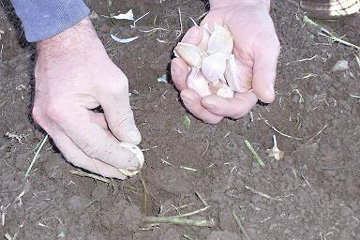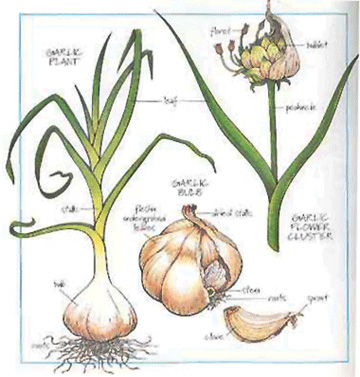
Volume XVII, Issue 37 # September 10 - September 16, 2009 |
 |
|
The Bay Gardener
 by Dr. Frank Gouin |

 As the Days Get Short, Plant Garlic and Onions
As the Days Get Short, Plant Garlic and Onions
Plan and plant now for early summer 2010 harvest
You can keep gardening all winter long if you plant garlic and short-day onions starting in mid- to late-September.
In the spring, we plant long-day or day-neutral onions, but for fall planting only short-day onions will do. That’s because, like garlic, short-day onions will form bulbs only when daylight hours are less than 12. You plant now to assure that they can grow sufficient foliage before the short-day period begins to produce large bulbs the following spring. In other words, the more foliage the plants have in the fall as they go into winter, the bigger the bulbs come spring.
Both onions and garlic grow best in a soil that is rich in organic matter. Before planting my garlic and fall onions, I spread an inch-thick layer of compost on the soil and spade it in. Using a dibble, I space my onion plants about four inches apart in beds. For regular garlic, I space the planting holes four inches apart, while for elephant garlic, I space the planting holes six inches part.
 The holes for regular garlic and onions should be about two inches deep, while the holes for the elephant garlic should be about four inches deep. Use only one clove of garlic per hole.
The holes for regular garlic and onions should be about two inches deep, while the holes for the elephant garlic should be about four inches deep. Use only one clove of garlic per hole.
After planting, water with a heavy stream of water to wash the soil around each plant or clove.
Onion plants and garlic bulbs can be purchased starting in mid-September from our local Southern States stores or ordered through gardening or nursery catalogs. I generally purchase my garlic from nursery catalogs and my onion plants from www.dixondaleonion.com Each bundle of onions contains about 75 plants no matter where you purchase them.
After the ground has frozen, I generally mulch both my onions and garlic with additional compost. The compost will help in keeping the soil uniformly moist and in minimizing freezing and thawing around the plants. The mulch layer of compost will also help in feeding the plants in the spring.
Start Now for Tomato Success Next Year
Q What can a home gardener who doesn’t have space for crop rotation and wants a tomato garden every year do about fusarium and verticillium wilts. Are containers the only option? A four- to six-year crop rotation is not for me! Even if I get resistant VFN plants, they still get the wilt disease.
–Michael Brownstein, via email
A The most effective method of controlling wilt diseases in a home garden with limited space is to plant a cover crop of winter rye in the fall as soon as the tomato plants are removed from the garden. In the spring, spread a two-inch thick layer of good compost and incorporate both compost and winter rye into the soil prior to planting the new year’s tomato plants. Beneficial organisms in rapidly decaying organic matter kill the disease-causing organisms.